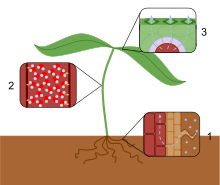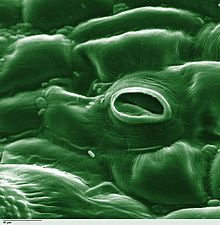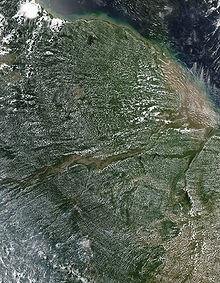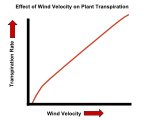What Process Do Plants Use To Draw Water Up From Their Roots To Their Leaves

Overview of transpiration:
- Water is passively transported into the roots so into the xylem.
- The forces of cohesion and adhesion crusade the water molecules to course a column in the xylem.
- Water moves from the xylem into the mesophyll cells, evaporates from their surfaces and leaves the institute by diffusion through the stomata

Transpiration of Water in Xylem


Transpiration is the process of water motion through a constitute and its evaporation from aerial parts, such as leaves, stems and flowers. Water is necessary for plants only only a pocket-size amount of water taken upward by the roots is used for growth and metabolism. The remaining 97–99.5% is lost by transpiration and guttation.[i] Leaf surfaces are dotted with pores chosen stomata (singular "stoma"), and in most plants they are more numerous on the undersides of the leaf. The stomata are bordered by baby-sit cells and their stomatal accessory cells (together known as stomatal complex) that open and close the pore.[2] Transpiration occurs through the stomatal apertures, and tin exist thought of as a necessary "cost" associated with the opening of the stomata to permit the diffusion of carbon dioxide gas from the air for photosynthesis. Transpiration too cools plants, changes osmotic pressure of cells, and enables mass period of mineral nutrients and water from roots to shoots. Two major factors influence the rate of water menses from the soil to the roots: the hydraulic electrical conductivity of the soil and the magnitude of the force per unit area gradient through the soil. Both of these factors influence the rate of majority flow of water moving from the roots to the stomatal pores in the leaves via the xylem.[3]
Mass flow of liquid water from the roots to the leaves is driven in part past capillary action, simply primarily driven by water potential differences. If the water potential in the ambient air is lower than the water potential in the leafage airspace of the stomatal pore, water vapor will travel down the gradient and move from the foliage airspace to the atmosphere. This move lowers the water potential in the leafage airspace and causes evaporation of liquid h2o from the mesophyll cell walls. This evaporation increases the tension on the water menisci in the cell walls and decrease their radius and thus the tension that is exerted on the water in the cells. Because of the cohesive properties of water, the tension travels through the leaf cells to the foliage and stalk xylem where a momentary negative pressure is created as water is pulled upward the xylem from the roots.[4] As evaporation occurs at the foliage surface, the properties of adhesion and cohesion work in tandem to pull water molecules from the roots, through xylem tissue, and out of the constitute through stomata.[five] In taller plants and trees, the force of gravity can but be overcome by the subtract in hydrostatic (water) force per unit area in the upper parts of the plants due to the diffusion of water out of stomata into the temper. Water is absorbed at the roots past osmosis, and whatsoever dissolved mineral nutrients travel with it through the xylem.
The cohesion-tension theory explains how leaves pull water through the xylem. Water molecules stick together, or exhibit cohesion. As a h2o molecule evaporates from the surface of the leaf, it pulls on the side by side h2o molecule, creating a continuous flow of water through the institute.[6]
Etymology [edit]
We can come across the history of the word transpiration when nosotros suspension it downwardly into trans, a Latin noun which means "beyond," and spiration, which comes from the Latin verb spīrāre, meaning "to breathe." The tion suffix adds the significant "the deed of," so we can see transpiration is, literally, "the ACT
of breathing across," which conspicuously identifies vapor emission from found leaves. Transpiration is vital to the earth'southward environmental, and is being reduced past our decimation of the forests.
Capillary activity [edit]
Capillary activeness is the process of a liquid flowing in narrow spaces without the assist of, or even in opposition to, external forces like gravity. The effect can be seen in the drawing up of liquids between the hairs of a pigment-castor, in a thin tube, in porous materials such as newspaper and plaster, in some non-porous materials such equally sand and liquefied carbon fiber, or in a biological cell. It occurs because of intermolecular forces betwixt the liquid and surrounding solid surfaces. If the diameter of the tube is sufficiently small, then the combination of surface tension (which is caused by cohesion inside the liquid) and adhesive forces betwixt the liquid and container wall act to propel the liquid.[vii]
Regulation [edit]
Plants regulate the rate of transpiration past controlling the size of the stomatal apertures. The rate of transpiration is also influenced by the evaporative need of the atmosphere surrounding the leaf such every bit boundary layer conductance, humidity, temperature, current of air and incident sunlight. Along with higher up footing factors, soil temperature and moisture tin can influence stomatal opening,[8] and thus transpiration charge per unit. The corporeality of water lost past a plant also depends on its size and the amount of water absorbed at the roots. Transpiration accounts for most of the water loss by a found past the leaves and immature stems. Transpiration serves to evaporatively cool plants, as the evaporating water carries abroad heat energy due to its large latent heat of vaporization of 2260 kJ per litre.
| Feature | Event on transpiration |
|---|---|
| Number of leaves | More leaves (or spines, or other photosynthesizing organs) means a bigger surface surface area and more than stomata for gaseous exchange. This volition outcome in greater water loss. |
| Number of stomata | More stomata will provide more than pores for transpiration. |
| Size of the foliage | A leaf with a bigger surface surface area will transpire faster than a leaf with a smaller surface area. |
| Presence of plant cuticle | A waxy cuticle is relatively impermeable to water and h2o vapour and reduces evaporation from the plant surface except via the stomata. A reflective cuticle volition reduce solar heating and temperature rising of the leaf, helping to reduce the rate of evaporation. Tiny hair-similar structures called trichomes on the surface of leaves besides tin can inhibit water loss by creating a loftier humidity environment at the surface of leaves. These are some examples of the adaptations of plants for conservation of water that may be plant on many xerophytes. |
| Low-cal supply | The rate of transpiration is controlled past stomatal aperture, and these small pores open up peculiarly for photosynthesis. While in that location are exceptions to this (such as night or CAM photosynthesis), in full general a light supply will encourage open stomata. |
| Temperature | Temperature affects the charge per unit in two ways: 1) An increased rate of evaporation due to a temperature rise will hasten the loss of water. |
| Relative humidity | Drier surroundings gives a steeper water potential gradient, and so increases the rate of transpiration. |
| Wind | In nonetheless air, water lost due to transpiration can accumulate in the form of vapor shut to the leafage surface. This volition reduce the rate of water loss, as the water potential gradient from inside to outside of the leaf is and then slightly less. Wind blows away much of this water vapor nigh the leaf surface, making the potential slope steeper and speeding up the diffusion of water molecules into the surrounding air. Fifty-fifty in air current, though, there may exist some accumulation of h2o vapor in a thin boundary layer of slower moving air adjacent to the leaf surface. The stronger the wind, the thinner this layer volition tend to be, and the steeper the water potential gradient. |
| Water supply | Water stress caused by restricted water supply from the soil may effect in stomatal closure and reduce the rates of transpiration. |
-

The effect of temperature on the transpiration rate of plants.
-

The consequence of wind velocity on the transpiration rate of plants.
-

The effect of humidity on the transpiration charge per unit of plants.

Some xerophytes will reduce the surface of their leaves during water deficiencies (left). If temperatures are cool enough and water levels are acceptable the leaves expand once again (right).
During a growing season, a foliage will transpire many times more than water than its own weight. An acre of corn gives off about iii,000–iv,000 gallons (eleven,400–15,100 liters) of water each day, and a big oak tree can transpire 40,000 gallons (151,000 liters) per yr. The transpiration ratio is the ratio of the mass of water transpired to the mass of dry thing produced; the transpiration ratio of crops tends to fall between 200 and 1000 (i.e., crop plants transpire 200 to grand kg of water for every kg of dry matter produced).[9]
Transpiration rates of plants can be measured by a number of techniques, including potometers, lysimeters, porometers, photosynthesis systems and thermometric sap flow sensors. Isotope measurements bespeak transpiration is the larger component of evapotranspiration.[10] Recent show from a global study[xi] of h2o stable isotopes shows that transpired water is isotopically dissimilar from groundwater and streams. This suggests that soil h2o is not as well mixed as widely causeless.[12]
Desert plants have specially adapted structures, such as thick cuticles, reduced leaf areas, sunken stomata and hairs to reduce transpiration and conserve water. Many cacti comport photosynthesis in succulent stems, rather than leaves, so the surface area of the shoot is very low. Many desert plants have a special blazon of photosynthesis, termed crassulacean acid metabolism or CAM photosynthesis, in which the stomata are closed during the day and open up at nighttime when transpiration will exist lower.
Cavitation [edit]
To maintain the pressure level gradient necessary for a plant to remain healthy they must continuously uptake water with their roots. They need to be able to run across the demands of h2o lost due to transpiration. If a plant is incapable of bringing in plenty h2o to remain in equilibrium with transpiration an event known equally cavitation occurs.[13] Cavitation is when the plant cannot supply its xylem with acceptable h2o and so instead of being filled with water the xylem begins to be filled with water vapor. These particles of water vapor come up together and grade blockages within the xylem of the found. This prevents the plant from being able to transport water throughout its vascular system.[14] There is no apparent pattern of where cavitation occurs throughout the plant'south xylem. If not finer taken care of, cavitation tin crusade a plant to reach its permanent wilting betoken, and die. Therefore, the constitute must have a method past which to remove this cavitation blockage, or it must create a new connection of vascular tissue throughout the plant.[xv] The establish does this by closing its stomates overnight, which halts the flow of transpiration. This then allows for the roots to generate over 0.05 mPa of pressure, and that is capable of destroying the blockage and refilling the xylem with water, reconnecting the vascular system. If a found is unable to generate plenty pressure to eradicate the blockage it must prevent the blockage from spreading with the employ of pit pears and then create new xylem that can re-connect the vascular system of the institute.[16]
Scientists have begun using magnetic resonance imaging (MRI) to monitor the internal status of the xylem during transpiration, in a non invasive manner. This method of imaging allows for scientists to visualize the movement of water throughout the entirety of the found. It also is capable of viewing what phase the h2o is in while in the xylem, which makes it possible to visualize cavitation events. Scientists were able to see that over the grade of xx hours of sunlight more than x xylem vessels began filling with gas particles becoming cavitated. MRI engineering also made it possible to view the process by which these xylem structures are repaired in the plant. After iii hours in darkness it was seen that the vascular tissue was resupplied with liquid water. This was possible considering in darkness the stomates of the plant are closed and transpiration no longer occurs. When transpiration is halted the cavitation bubbles are destroyed by the force per unit area generated by the roots. These observations advise that MRIs are capable of monitoring the functional status of xylem and allows scientists to view cavitation events for the start time.[15]
See also [edit]
- Antitranspirant – a substance to preclude transpiration
- Awning conductance
- Ecohydrology
- Eddy covariance flux (aka eddy correlation, eddy flux)
- Hydrology (agriculture)
- Latent estrus flux
- Perspiration
- Soil plant temper continuum
- Stomatal conductance
- Transpiration stream
- Turgor pressure level
- Water Evaluation And Planning system (WEAP)
References [edit]
- ^ Sinha, Rajiv Kumar (2004-01-01). Mod Establish Physiology. CRC Press. ISBN978-0-8493-1714-ix.
- ^ Benjamin Cummins (2007), Biological science (3 ed.), Freeman, Scott, p. 215
- ^ Taiz, Lincoln (2015). Establish Physiology and Development. Sunderland, MA: Sinauer Assembly, Inc. p. 101. ISBN978-1-60535-255-8.
- ^ Freeman, Scott (2014). Biological Sciences. Us of America: Pearson. pp. 765–766. ISBN978-0-321-74367-1.
- ^ Simon, E.J., Dickey, J.L, & Reece, J.B. (2019). Campbell essential biology. seventh New York: Pearson
- ^ Graham, Linda E. (2006). Constitute Biological science. Upper Saddle River, NJ 07458: Pearson Educational activity, Inc. pp. 200–202. ISBN978-0-13-146906-8.
{{cite book}}: CS1 maint: location (link) - ^ "Capillary Activeness – Liquid, Water, Force, and Surface – JRank Articles". Science.jrank.org. Archived from the original on 2013-05-27. Retrieved 2013-06-18 .
- ^ Mellander, Per-Erik; Bishop, Kevin; Lundmark, Tomas (2004-06-28). "The influence of soil temperature on transpiration: a plot scale manipulation in a young Scots pine stand". Forest Ecology and Direction. 195 (1): 15–28. doi:x.1016/j.foreco.2004.02.051. ISSN 0378-1127.
- ^ Martin, J.; Leonard, W.; Postage, D. (1976), Principles of Field Crop Production (3rd ed.), New York: Macmillan Publishing Co., ISBN978-0-02-376720-iii
- ^ Jasechko, Scott; Sharp, Zachary D.; Gibson, John J.; Birks, Southward. Jean; Yi, Yi; Fawcett, Peter J. (3 April 2013). "Terrestrial water fluxes dominated past transpiration". Nature. 496 (7445): 347–50. Bibcode:2013Natur.496..347J. doi:10.1038/nature11983. PMID 23552893. S2CID 4371468.
- ^ Evaristo, Jaivime; Jasechko, Scott; McDonnell, Jeffrey J. (2015-09-03). "Global separation of constitute transpiration from groundwater and streamflow". Nature. 525 (7567): 91–94. Bibcode:2015Natur.525...91E. doi:10.1038/nature14983. ISSN 0028-0836. PMID 26333467. S2CID 4467297.
- ^ Bowen, Gabriel (2015-09-03). "Hydrology: The diversified economics of soil water". Nature. 525 (7567): 43–44. Bibcode:2015Natur.525...43B. doi:10.1038/525043a. ISSN 0028-0836. PMID 26333464. S2CID 205086035.
- ^ Zhang, Yong-Jiang (December 2016). "Reversible Leaf Xylem Collapse: A Potential "Circuit Breaker" confronting Cavitation". Found Physiology. 172 (four): 2261–2274. doi:x.1104/pp.16.01191. PMC5129713. PMID 27733514.
- ^ Hochberg, Uri (June 2017). "Stomatal Closure, Basal Leaf Embolism, and Shedding Protect the Hydraulic Integrity of Grape Stems". Constitute Physiology. 174 (ii): 764–775. doi:ten.1104/pp.sixteen.01816. PMC5462014. PMID 28351909.
- ^ a b Holbrook, Michele (May 2001). "In Vivo Observation of Cavitation and Embolism Repair Using Magnetic Resonance Imaging". Plant Physiology. 126 (1): 27–31. doi:ten.1104/pp.126.1.27. PMC1540104. PMID 11351066.
- ^ Tiaz, Lincoln (2015). Constitute Physiology and Evolution. Massachusetts: Sinauer Assembly, Inc. p. 63. ISBN978-1605352558.
External links [edit]
- USGS The Water Cycle: Evapotranspiration
Source: https://en.wikipedia.org/wiki/Transpiration
Posted by: boedingtorned1980.blogspot.com


0 Response to "What Process Do Plants Use To Draw Water Up From Their Roots To Their Leaves"
Post a Comment